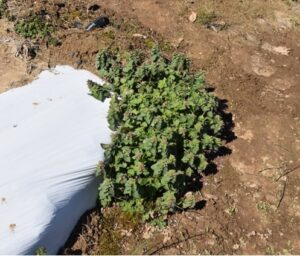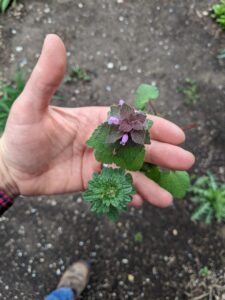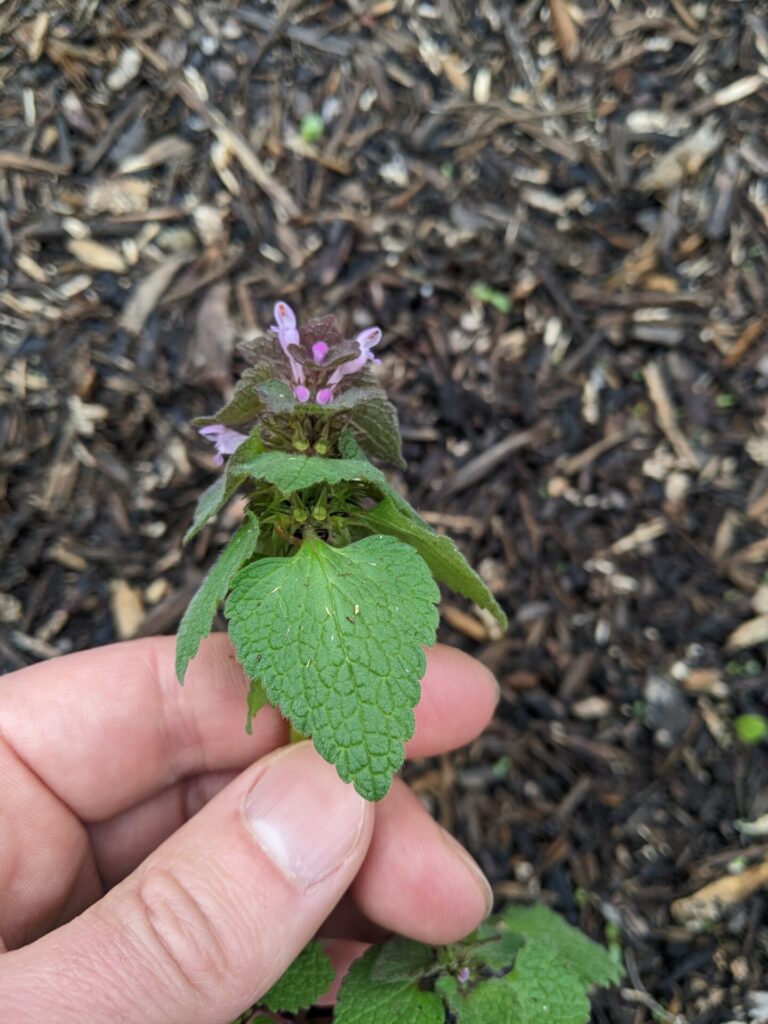Common Names
Purple deadnettle, red deadnettle.
Latin name
Lamium purpureum.
- “Lamium” is derived from the Latin for “throat,” referencing the flower tube’s elongated shape.
- “purpureum”, also derived from the Latin, means “purple”.
Family
Lamiaceae – “the mint family”.
Life cycle
In Indiana, purple deadnettle is a winter annual. Plants emerge as small seedlings in the fall and overwinter. In late winter and early spring, plants mature (Figure 1) and flower, producing seeds by late spring. After setting seeds, the plants die.

Figure 1. A purple deadnettle plant grows at the end of a plasticulture strawberry row in Vincennes, IN (Photo by Carlos Lopez).
Identification
Seedling
Purple deadnettles have two hairless seed leaves (“cotyledons”). Each cotyledon has two lobes at the base, and its tips are flat or slightly indented. The young leaves have soft hairs and appear in pairs across the stem from each other, known as an “opposite” leaf arrangement (as opposed to an “alternate” leaf arrangement).
Mature Plants
Mature plants form low-growing clumps, with the growing points extending upward as the plant matures. Purple deadnettle stems are square and hollow (Figures 2 and 3). Purple deadnettle can be distinguished from henbit by its more triangular-shaped leaves (Figure 4). Additionally, all purple deadnettle leaves attach to the stem with a petiole (Figure 5); upper leaves do not wrap around the stem like those of henbit. Flowers appear in whorls around the upper portion of the plant. The flowers, which are typically light purple in color, have fused petals and appear “hidden” between rows of leaves.

Figure 4. Purple deadnettle (above) leaves are more triangular in shape than the leaves of its close relative, henbit (below) (Photo by Stephen Meyers).

Figure 5. Purple deadnettle leaves at the top of the plant attach to the stem with a short petiole (Photo by Stephen Meyers).
Integrated weed management strategy
Cultural and mechanical practices
- Scouting: Conduct monitoring in the fall after tilling (if applicable) or spring to identify purple deadnettle patches and plan control strategies accordingly.
- Cover crops: Utilize cover crops to outcompete purple deadnettle for resources and provide a physical barrier to its growth. Integrating fall-planted cover crops can disrupt purple deadnettle’s life cycle.
- Plastic mulch: Acting as a physical barrier, plastic mulch hinders germinating purple deadnettle seedlings from reaching the soil surface. Ensure that planting holes are sized to fit only your transplant. Excessively large planting holes can allow weeds to emerge next to the crop.
- Silage tarps: Silage tarps prevent germinating weeds from receiving sunlight. Tarps placed in the fall and removed in the spring will effectively control purple deadnettle. Alternatively, tarps can be placed in the spring prior to purple deadnettle seed set and allowed to remain in place for at least three weeks.
- Hand-weeding, hoeing, and cultivation: Eliminate seedlings before seed production to prevent an increase in the weed seed bank. Tillage can be used in the fall after purple deadnettle and other winter annuals have emerged. However, if the soil is left bare, it can be susceptible to erosion from wind and water.
- Flame weeding: Use flame weeding to control purple deadnettle in its early stages of growth.
Chemical control
- Pre-emergence (PRE) herbicides: Because purple deadnettle emerges in the fall, the use of PRE herbicides in annual vegetable crops may not be advisable, especially if fall/winter cover crops will be planted.
- Post-emergence (POST) herbicides: Apply POST herbicides to purple deadnettle in the spring before planting/transplanting. Depending on your production system, this can be done instead of, or in addition to, spring tillage.
- Visit the Midwest Vegetable Production Guide (mwveguide.org) to learn which herbicides are labeled for the crops you intend to grow.
For some, no management is also an option. Purple deadnettle can provide living roots during the fall, winter, and early spring when many vegetables are not in the field. They will naturally senesce before many summer vegetable crops are planted. They also provide an early source of pollen for pollinators.

